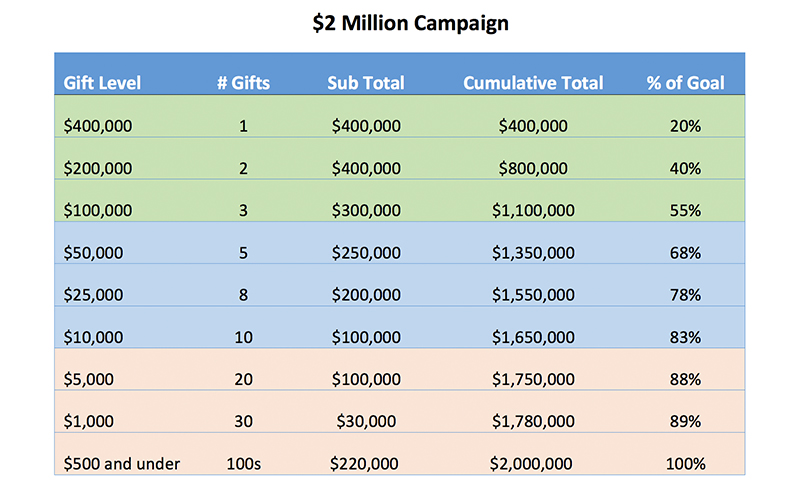
The art of getting a gift from a solicitation visit is a delicate balance of strategy, psychology, and personalization. One key element that can make or break the success of these visits is the approach to requesting a specific amount from donors.
When it comes to fundraising solicitation, the strategy behind asking for donations can significantly impact the success of your campaign. Two common approaches are requesting a specific amount versus presenting a range of gift options. Each method has its merits, influenced by donor maturity, comfort levels of volunteers, and the overall goals of your organization.
The Case for Asking for a Specific Amount when Seeking a Gift
Clarity and Confidence
The human mind is wired to respond better to specific, concrete requests rather than open-ended ones. When we ask a donor to contribute a precise amount, we are tapping into the psychological principle of anchoring. This cognitive bias causes people to rely heavily on the first piece of information they encounter (the specific amount) when making decisions. By presenting a well-researched and thoughtfully determined specific amount, we can influence the donor’s perception of what constitutes a meaningful contribution.
Asking for a specific amount can also provide clarity and instill confidence in both the fundraiser and the donor. When you present a defined figure, it eliminates ambiguity, allowing donors to make quicker decisions. For example, instead of saying, “Would you consider making a gift?” you might say, “Would you consider a gift of $5,000 to support our new initiative?” This direct approach often resonates well, especially with mature donors who appreciate straightforwardness.
Metrics Matter
Data from various fundraising studies show that specific asks can lead to higher average gift sizes. According to research from the Association of Fundraising Professionals, campaigns that include a precise ask often see a 20% increase in revenue compared to those that present a range. This is particularly true when targeting major donors or individuals with established relationships with your organization, as they often have the capacity and willingness to give at defined levels.
Tailored Appeals
When you ask for a specific amount, it allows for more personalized appeals. Fundraisers can tailor their asks based on the donor’s past giving history and engagement level. For instance, if a donor has previously given $3,000, a solicitation for $5,000 is a natural next step, demonstrating growth in the organization’s needs while acknowledging their previous generosity.
The Power of Gift Ranges
Comfort for Volunteers
On the flip side, presenting a range of gift options can provide comfort for volunteers who may feel hesitant about asking for a large sum. A gift range of $1,000 to $5,000 allows volunteers to gauge a donor’s comfort level without the pressure of a specific ask. This approach can be particularly effective for new volunteers who are still building confidence in their solicitation skills.
While a specific amount request and a gift range both serve important purposes in fundraising, they differ in their approach and intended outcomes. A gift range, such as “Please consider a gift of $50, $100, or $250,” provides donors with a range of options to choose from, allowing them to select the level of giving that best fits their capacity and comfort. This approach can be particularly effective in cultivating new donors or reaching a broader audience. I have found that if you show the donor a gift chart (see example below), and ask “where do you see yourself fitting in” usually has a positive result.

Engaging New Donors
Gift ranges can also be advantageous when engaging potential new donors. For individuals unfamiliar with your organization, a range can make giving feel more accessible. This can be particularly effective for community fundraising events or when targeting a broader audience. The flexibility encourages participation at different levels, increasing the likelihood of a positive response.
Metrics of Engagement
Studies show that campaigns using gift ranges can lead to a higher number of gifts, even if the average gift size is smaller. This strategy can foster a sense of inclusivity and community, appealing to those who may feel uncomfortable with a more aggressive approach. Additionally, it allows organizations to capture gifts from a wider array of donors, which can be vital for long-term sustainability.
Finding the Right Balance will Maximize the Gift
The choice between asking for a specific amount or a range often depends on several factors, including the maturity of your donor base, the confidence of your volunteers, and the nature of the fundraising initiative. Here are some key considerations:
- Know Your Donors: Understanding your donor base’s giving habits and preferences can guide your strategy. Mature donors might respond better to specific asks, while newer or less-engaged donors may prefer a range.
- Training Volunteers: Equip your volunteers with the tools and confidence they need. Providing training sessions on how to present both specific asks and ranges can enhance their effectiveness, regardless of the method used.
- Adjust Based on Feedback: Pay attention to donor responses. If you notice that specific asks are met with hesitation, consider incorporating ranges for future solicitations.
- Use a Hybrid Approach: In some cases, a combination of both strategies can be beneficial. Start with a range to gauge interest, then transition to a specific ask based on the conversation’s flow and the donor’s engagement.
Conclusion
Both asking for a specific amount and presenting a gift range have their place in fundraising solicitation. Understanding the dynamics of your donor base, the comfort level of your volunteers, and the context of your campaign will ultimately determine the most effective approach. By striking the right balance, you can optimize your fundraising efforts, foster meaningful donor relationships, and drive your organization’s mission forward. Remember, at the heart of successful fundraising is genuine connection—regardless of the ask.
Until next week,
L’chaim.
jack




